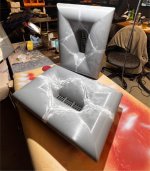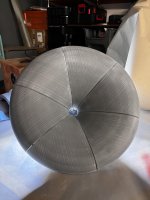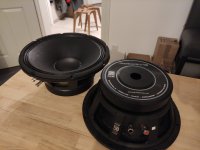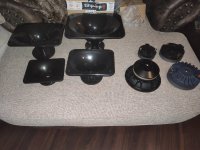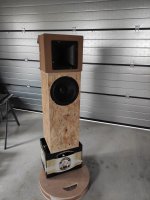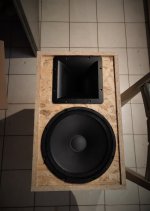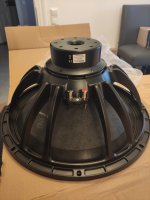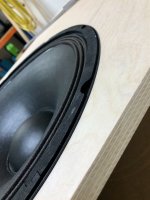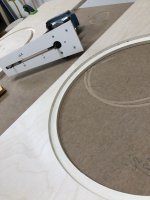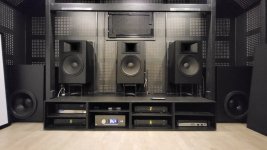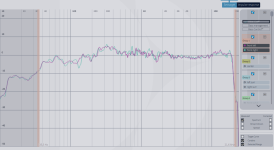I would have preferred German oak, but he said it would sound a bit more spirited with Italian wood. 🤷♂️😅
I had been in contact with Flaxxer for some time, so I already knew roughly what the outcome would be. But the result is of course still very impressive.
Impressive work!
the tweeter is pointing upward?
And are these baffle like 4 inches thick? These speakers must weight a ton!
Hi there. It's not "the" tweeter. The horn itself plays flat to about 18k, where it starts to roll off. My client was concerned this may remove the sense of "air" and sparkle he was used to. So I added super tweeters that fire upwards. I measured them firing straight forward, but the phase/timing was off. When firing upwards, they measured almost perfect.
Please note the super tweeters can be turned completely off, and they have a volume control that allows up to -6db of reduction. They also have adjustable xovers. They can be brought in as low as 8k or can be brought in from just 16k upwards.
They are not really there to be heard directly, as much as an ambience tweeter. They play to 40k!
They weigh ... a ton! But it's just doubled 3/4" baltic birch. For 1.5" thick baffles. It just looks thicker due to the layer lines in the plywood.
I'd like to take a moment to thank Rese66. I've never been but so interested in horns, because they aren't designed for home hifi. I've had a love/hate relationship with Klipsch (the pros and cons). When Volti came out I was excited! Until I heard them, and saw the actual measurements.
Rese66 has given the community a fabulous design that most everyone can afford. And it is very, very good. It accomplishes the balance of pro drivers and hifi quality. And this is what I want to clarify: Rese66 had specific design goals to make the best speaker he could for low cost... and he did!
I never wanted to change the design in any way. I just wanted to see how far it could be pushed.
He and I disagree on xover parts, upgraded wiring, etc. I find I can consistently hear differences in these.
However I am not sure how much difference a person can hear, if the large cabinets and thin horn lens are vibrating. With my degree and background being in siesmology/vibration control, I use an accelerometer and oscilloscope to measure these. These cabinets and added modifications make for a very dead, but not damped platform for the drivers to shine.
For my purposes, upgrading resistors and capacitors only cost an extra $100 -$150. The design allows for capacitor changes, even while music is playing .... and I'd LOVE to host a party for cap rolling in these! Talk about a different voice!
So the idea for this version, was to be as hi end as reasonable, to give tbe design it's full opportunity. This was sound quality ONLY .... and hope they look good too designing!
Even that stinking denim insulation cost more than an Overnight Sensations speaker kit! Almost twice as much.
Are there REAL differences?
You can not compare a 3/4" cabinet if this size, to cabinets made this over the top. You WILL have significant resonance and vibration differences that will change what you hear. But this is important in any speaker imo.
Between the crazy good off axis dispersion, and addressing vibrations at every corner, these dissappear in a room like football sized mini monitors. Soundstage is above and behind you. When you crank it up loud, nothing changes. It keeps it's tonality and character.
These are fine speakers, and especially at their dirt cheap cost of enjoyment! Thanks, O!
Rese66 has given the community a fabulous design that most everyone can afford. And it is very, very good. It accomplishes the balance of pro drivers and hifi quality. And this is what I want to clarify: Rese66 had specific design goals to make the best speaker he could for low cost... and he did!
I never wanted to change the design in any way. I just wanted to see how far it could be pushed.
He and I disagree on xover parts, upgraded wiring, etc. I find I can consistently hear differences in these.
However I am not sure how much difference a person can hear, if the large cabinets and thin horn lens are vibrating. With my degree and background being in siesmology/vibration control, I use an accelerometer and oscilloscope to measure these. These cabinets and added modifications make for a very dead, but not damped platform for the drivers to shine.
For my purposes, upgrading resistors and capacitors only cost an extra $100 -$150. The design allows for capacitor changes, even while music is playing .... and I'd LOVE to host a party for cap rolling in these! Talk about a different voice!
So the idea for this version, was to be as hi end as reasonable, to give tbe design it's full opportunity. This was sound quality ONLY .... and hope they look good too designing!
Even that stinking denim insulation cost more than an Overnight Sensations speaker kit! Almost twice as much.
Are there REAL differences?
You can not compare a 3/4" cabinet if this size, to cabinets made this over the top. You WILL have significant resonance and vibration differences that will change what you hear. But this is important in any speaker imo.
Between the crazy good off axis dispersion, and addressing vibrations at every corner, these dissappear in a room like football sized mini monitors. Soundstage is above and behind you. When you crank it up loud, nothing changes. It keeps it's tonality and character.
These are fine speakers, and especially at their dirt cheap cost of enjoyment! Thanks, O!
Impressive work!
the tweeter is pointing upward?
And are these baffle like 4 inches thick? These speakers must weight a ton!
I just went back and saw what you're referring to 😆. I hadn't installed the second baffle yet, in those 2 photos you saw. I had lain the second baffle on the first baffle. And indeed it was temporarily 3" thick in those two photos. Good catch!
Flaxxer,
Thanks for sharing the build photos. For folks passionate about DIY, it's interesting to see how the actual build takes place stage by stage, and what techniques were used by the builder.
However. more often than not, pics aren't taken - good that you snapped a few. 🙂
Thanks for sharing the build photos. For folks passionate about DIY, it's interesting to see how the actual build takes place stage by stage, and what techniques were used by the builder.
However. more often than not, pics aren't taken - good that you snapped a few. 🙂
The maple veneer work is truly heroic, epic... well done !
Highly figured veneer is SO SO difficult to work with. I would not attempt to do what you have done.
Highly figured veneer is SO SO difficult to work with. I would not attempt to do what you have done.
Thank you very much for the very kind words!
I'm always very happy when people who recreate my designs end up happy with the sound.
And this is DIY - everyone can do it to their own taste. If someone wants to use expensive cables or high-end X-Over components, I have absolutely nothing against it.
It's just important to me that the tutorial doesn't claim that the whole speaker sounds better with a cap for 30$, even though one for 2$ does it just as well.
I always keep an eye on the price/performance ratio, because most people want as much sound as possible for the best price.
I'm always very happy when people who recreate my designs end up happy with the sound.
And this is DIY - everyone can do it to their own taste. If someone wants to use expensive cables or high-end X-Over components, I have absolutely nothing against it.
It's just important to me that the tutorial doesn't claim that the whole speaker sounds better with a cap for 30$, even though one for 2$ does it just as well.
I always keep an eye on the price/performance ratio, because most people want as much sound as possible for the best price.
I thank Rese66 for sharing Asathor design here in diyaudio 🙂
Im very curious about its woofer module and among other things there aren't that many closed-principle big woofer designs available. Im interested about trying Asathor's woofer module in a few of my projects I'm working on: Athex 400-36 (By Mabat) and then also Horn.1931 (By Joseph Crowe) I've 3d-printed both and I'm currently finishing them. I know that fitting Asathors woofer module to either requires careful adjustment of the crossover (I plan to cross H.1931 at 500Hz and Athex at approx 750Hz) Would it be possible to get woofers inbox zma and far & near measurements for WSF152.50? It would be interesting and good training to upload those in Vituixcad and study things. I plan to make my own measurements later, my bigger turning table is under work at the moment.
Im very curious about its woofer module and among other things there aren't that many closed-principle big woofer designs available. Im interested about trying Asathor's woofer module in a few of my projects I'm working on: Athex 400-36 (By Mabat) and then also Horn.1931 (By Joseph Crowe) I've 3d-printed both and I'm currently finishing them. I know that fitting Asathors woofer module to either requires careful adjustment of the crossover (I plan to cross H.1931 at 500Hz and Athex at approx 750Hz) Would it be possible to get woofers inbox zma and far & near measurements for WSF152.50? It would be interesting and good training to upload those in Vituixcad and study things. I plan to make my own measurements later, my bigger turning table is under work at the moment.
Attachments
Last edited:
Sorry to jump in, but I would really like to see the measurements of the 1931 horn - if the phase plug gets rid of the 7 kHz problem.
Hello!
Those are interesting designs.
I have some other projects to measure in the next few days, I may measure the Asathor again with my new Clio measuring system.
Here are a few impressions of the current projects:
Those are interesting designs.
I have some other projects to measure in the next few days, I may measure the Asathor again with my new Clio measuring system.
Here are a few impressions of the current projects:
Attachments
@Rese66, I'm thrilled to have come across your Asathor build.
I've been searching for 'hifi' speakers featuring the H1-9040 horn to compare them with my own setup.
I built this kit a couple of years ago : https://celestion.com/blog/build-this-15-two-way-pa-cabinet-design/
Currently, the speakers are housed in sealed 75-liter cases, integrated into my home theater setup.
However, I find the bass to be rather light, starting to roll off after about 150 Hz.
I was considering adding ports, following the original schematics, to enhance the low end.
I don't need to go super low since I have subwoofers for that purpose. Is this a good idea?
Upon comparing the specifications, it appears that your Lavoice driver might be a better match for my sealed case than the TF1525e.
While going through this thread, I've been searching for information on the radiation patterns of these horns. Initially, I thought they were constant directivity horns, but it seems they are indeed exponential horns, so they seem to be a rather narrow directivity? Is this correct?
I sit relatively close to the speakers (2.3 meters) and currently have their height adjusted so that the ear level aligns between the bass driver and the horn. Would this be correct?
The speakers are positioned 2 meters apart behind an acoustical screen.
Would you recommend any toe-in, condering their radiation pattern?
I've been contemplating whether this crossover design is more suitable for home use or geared towards PA usage,
considering the relatively high crossover to protect the tweeter.
Do you think this design can be improved, or would it be better to explore other designs?
I do like how these sound, but it is very difficult to find anything to compare them too....
I've been searching for 'hifi' speakers featuring the H1-9040 horn to compare them with my own setup.
I built this kit a couple of years ago : https://celestion.com/blog/build-this-15-two-way-pa-cabinet-design/
Currently, the speakers are housed in sealed 75-liter cases, integrated into my home theater setup.
However, I find the bass to be rather light, starting to roll off after about 150 Hz.
I was considering adding ports, following the original schematics, to enhance the low end.
I don't need to go super low since I have subwoofers for that purpose. Is this a good idea?
Upon comparing the specifications, it appears that your Lavoice driver might be a better match for my sealed case than the TF1525e.
While going through this thread, I've been searching for information on the radiation patterns of these horns. Initially, I thought they were constant directivity horns, but it seems they are indeed exponential horns, so they seem to be a rather narrow directivity? Is this correct?
I sit relatively close to the speakers (2.3 meters) and currently have their height adjusted so that the ear level aligns between the bass driver and the horn. Would this be correct?
The speakers are positioned 2 meters apart behind an acoustical screen.
Would you recommend any toe-in, condering their radiation pattern?
I've been contemplating whether this crossover design is more suitable for home use or geared towards PA usage,
considering the relatively high crossover to protect the tweeter.
Do you think this design can be improved, or would it be better to explore other designs?
I do like how these sound, but it is very difficult to find anything to compare them too....
Merry Xmas speaker builders!
Just a little note from my project. Four days ago DHL finally delivered the «out-of-stock» Celestion horns. Two months of waiting is over, and it's time to continue the building. Both Lavoce 15" is in place. Hopefully, I will find some time tomorrow and install the horns.

Just a little note from my project. Four days ago DHL finally delivered the «out-of-stock» Celestion horns. Two months of waiting is over, and it's time to continue the building. Both Lavoce 15" is in place. Hopefully, I will find some time tomorrow and install the horns.
Attachments
The H1-9040 is an exponential horn, correct. However, the beam angle is relatively large at 90°.@Rese66, I'm thrilled to have come across your Asathor build.
I've been searching for 'hifi' speakers featuring the H1-9040 horn to compare them with my own setup.
I built this kit a couple of years ago : https://celestion.com/blog/build-this-15-two-way-pa-cabinet-design/
Currently, the speakers are housed in sealed 75-liter cases, integrated into my home theater setup.
However, I find the bass to be rather light, starting to roll off after about 150 Hz.
I was considering adding ports, following the original schematics, to enhance the low end.
I don't need to go super low since I have subwoofers for that purpose. Is this a good idea?
Upon comparing the specifications, it appears that your Lavoice driver might be a better match for my sealed case than the TF1525e.
While going through this thread, I've been searching for information on the radiation patterns of these horns. Initially, I thought they were constant directivity horns, but it seems they are indeed exponential horns, so they seem to be a rather narrow directivity? Is this correct?
I sit relatively close to the speakers (2.3 meters) and currently have their height adjusted so that the ear level aligns between the bass driver and the horn. Would this be correct?
The speakers are positioned 2 meters apart behind an acoustical screen.
Would you recommend any toe-in, condering their radiation pattern?
I've been contemplating whether this crossover design is more suitable for home use or geared towards PA usage,
considering the relatively high crossover to protect the tweeter.
Do you think this design can be improved, or would it be better to explore other designs?
I do like how these sound, but it is very difficult to find anything to compare them too....
Unfortunately, I don't know the CKT-TF1525e system, but it is probably designed as a large PA top and therefore pays a lot of attention to high sensitivity. This could of course be changed for home hifi, but would require a completely new x-over design.
If you like the sound, I wouldn't change anything about the x-over.
The lack of bass surprises me a little, because the Celestion TF1525e also runs very well in the sealed 75L and is very similar to my LaVoce:
I am therefore very surprised that it is already weak below 150Hz.
Thank you for your response. However, I've noticed that the speakers appear to lack bass, even when positioned against the wall.
I have attached average measurements for the front speakers and the current layout, prompting my question about porting.
Ideally, I would like the bass to start lifting at 400Hz and add about 3dB at 100Hz. Since the original was ported I assumed it would make the speakers less "thin" sounding.
Your Lavoices seem to be more evenly-behaved bass drivers, but they likely punch in the same weight class as the Celestions.
Your speakers, on the other hand, appear to be much smoother and more refined sounding than my current boxes. (Your crossover is notably more complex).
I am interested in refining and improving the frequency response of my current speakers, with a new crossover. Examining the response of the Celestion box, it starts to rise above 10kHz. These respond well to EQ adjustments with Dirac, but as is normal I would like to have better starting point.
There's something "physical" and "effortless" about these big boxes that smaller speakers just cannot match. Besides, learning is fun!
Sorry for the offtopic...I would have contacted you via PM @Rese66 , but I am not allowed yet.
So should I port these?
I have attached average measurements for the front speakers and the current layout, prompting my question about porting.
Ideally, I would like the bass to start lifting at 400Hz and add about 3dB at 100Hz. Since the original was ported I assumed it would make the speakers less "thin" sounding.
Your Lavoices seem to be more evenly-behaved bass drivers, but they likely punch in the same weight class as the Celestions.
Your speakers, on the other hand, appear to be much smoother and more refined sounding than my current boxes. (Your crossover is notably more complex).
I am interested in refining and improving the frequency response of my current speakers, with a new crossover. Examining the response of the Celestion box, it starts to rise above 10kHz. These respond well to EQ adjustments with Dirac, but as is normal I would like to have better starting point.
There's something "physical" and "effortless" about these big boxes that smaller speakers just cannot match. Besides, learning is fun!
Sorry for the offtopic...I would have contacted you via PM @Rese66 , but I am not allowed yet.
So should I port these?
Attachments
The measurement doesn't look bad in the mid-high range, I wouldn't change anything there.
There is a slight weakness in the bass below 200Hz, but this is also the range in which the room has a major influence.
The Celestion actually needs a much larger cabinet for bass reflex, but in your case it would fit, because the small volume in combination with the ports brings about +3dB at 100Hz:

The red curve corresponds to your box with two ports with 12cm (4.7") diameter and 15cm (5.9") length.
Perhaps you could try this on just one speaker and listen to the result.
However, you should not place the ports on the front. With 2-way speakers, a lot of midrange and resonance always comes out of the ports. I would therefore place them in the bottom so that the interference does not radiate directly towards the listener.
There is a slight weakness in the bass below 200Hz, but this is also the range in which the room has a major influence.
The Celestion actually needs a much larger cabinet for bass reflex, but in your case it would fit, because the small volume in combination with the ports brings about +3dB at 100Hz:
The red curve corresponds to your box with two ports with 12cm (4.7") diameter and 15cm (5.9") length.
Perhaps you could try this on just one speaker and listen to the result.
However, you should not place the ports on the front. With 2-way speakers, a lot of midrange and resonance always comes out of the ports. I would therefore place them in the bottom so that the interference does not radiate directly towards the listener.
@Rese66 r Thanks for your feedback and thoughts.
Even though it's not specifically about the Asathor but more related to its younger counterpart, Thrud, you have been generous with thoughts.
I would have preferred to discuss this privately via PM, but I currently do not have the rights to do so.
( I do not know if you want to contact me and we continue this discussion over PM instead as to not clutter up this thread).
Using WinISD simulation, I obtain a graph similar to yours, with bass starting at around 400 Hz and ending with a peak of the 3dB at 100 Hz.
I've already purchased the ports recommended for this build, as outlined in the following PDF: https://celestion.com/wp-content/uploads/2019/10/188.pdf
If you take a look at the PDF, you can find more details about the crossover and case.
.The recommended ports have a diameter of 10 cm and a length of 6 cm.
I'll follow your suggestion and build only one for testing purposes.
Unfortunately, I can't place the ports at the bottom due to the speaker standing on isolation feet. However, I'll ensure to dampen them effectively behind the driver.
I find it peculiar that the speakers aren't receiving much support from the room under 200 Hz.
This aligns closely with the estimated response, even when placing them right up against the wall.
Could there be an issue with my crossover, or is the cabinet possibly overstuffed?
My room is on a floating floor in a wooden house with the rear side opening up to a much larger space, so it probably provides rather little room gain.
Even though it's not specifically about the Asathor but more related to its younger counterpart, Thrud, you have been generous with thoughts.
I would have preferred to discuss this privately via PM, but I currently do not have the rights to do so.
( I do not know if you want to contact me and we continue this discussion over PM instead as to not clutter up this thread).
Using WinISD simulation, I obtain a graph similar to yours, with bass starting at around 400 Hz and ending with a peak of the 3dB at 100 Hz.
I've already purchased the ports recommended for this build, as outlined in the following PDF: https://celestion.com/wp-content/uploads/2019/10/188.pdf
If you take a look at the PDF, you can find more details about the crossover and case.
.The recommended ports have a diameter of 10 cm and a length of 6 cm.
I'll follow your suggestion and build only one for testing purposes.
Unfortunately, I can't place the ports at the bottom due to the speaker standing on isolation feet. However, I'll ensure to dampen them effectively behind the driver.
I find it peculiar that the speakers aren't receiving much support from the room under 200 Hz.
This aligns closely with the estimated response, even when placing them right up against the wall.
Could there be an issue with my crossover, or is the cabinet possibly overstuffed?
My room is on a floating floor in a wooden house with the rear side opening up to a much larger space, so it probably provides rather little room gain.
We can certainly discuss this further here. It may also be of interest to other people.
Two 10 cm tubes with a length of 6 cm are ok. The bass reflex ports should be as large as possible for speakers with such high sound pressure levels.
If the cabinets are damped too much, bass reflex will not work properly. There should be no damping between the woofer and the port.
Maybe you can put the channels on the side, anything is better than the front.
Here you can see what is emitted from such a bass reflex port. Red is the driver, black is the port.
From around 400Hz, very strong interference comes out of the port, which has a very negative effect on the sound if it radiates directly towards the listener.

Wooden houses and floating floors can vibrate strongly. They then act as absorbers and absorb bass. So this could very well be the reason for your problem.
Two 10 cm tubes with a length of 6 cm are ok. The bass reflex ports should be as large as possible for speakers with such high sound pressure levels.
If the cabinets are damped too much, bass reflex will not work properly. There should be no damping between the woofer and the port.
Maybe you can put the channels on the side, anything is better than the front.
Here you can see what is emitted from such a bass reflex port. Red is the driver, black is the port.
From around 400Hz, very strong interference comes out of the port, which has a very negative effect on the sound if it radiates directly towards the listener.
Wooden houses and floating floors can vibrate strongly. They then act as absorbers and absorb bass. So this could very well be the reason for your problem.
- Home
- Loudspeakers
- Multi-Way
- Asathor - a JBL 4367 Clone

